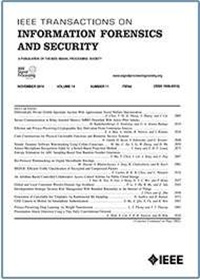Sensing for Jamming in ISAC: Beam Scanning and Beamforming Optimization
IF 8
1区 计算机科学
Q1 COMPUTER SCIENCE, THEORY & METHODS
IEEE Transactions on Information Forensics and Security
Pub Date : 2025-06-25
DOI:10.1109/TIFS.2025.3583251
引用次数: 0
Abstract
The development of wireless technology enables numerous applications of remote-controlled devices (e.g., uncrewed aerial vehicles), yet their intrusion poses significant threats to restricted areas, including military bases, airports, and private spaces belonging to individuals and organizations. To effectively counter the intruders, we propose a novel sensing assisted jamming (SAJA) scheme in two-stage transmission protocol, where we are the first to employ beam scanning to enhance the jamming gain to neutralize intruders. In the first stage, we determine the number of sensing beams L for detecting intruders. We show that a larger L leads to a more accurate angle range, thus enabling a higher jamming beam gain. In the second stage, robust jamming beamforming is designed to disable the intruders within the estimated angle range. The problem facing a single intruder is already non-convex, and we decouple it into two subproblems and develop algorithms for both single- and multi-intruder scenarios. In single-intruder scenarios, we first derive the closed-form expression for robust beamforming design with fixed L, and then apply the bisection search method to determine the minimum L. Facing multiple possible intruders, we further design a multi-round anti-intruder algorithm to address power insufficiency. In each round, we check the problem feasibility withISAC干扰检测:波束扫描与波束成形优化
无线技术的发展使远程控制设备(如无人驾驶飞行器)的应用成为可能,但它们的入侵对限制区域构成了重大威胁,包括军事基地、机场和属于个人和组织的私人空间。为了有效地对抗入侵者,我们在两阶段传输协议中提出了一种新的传感辅助干扰(SAJA)方案,其中我们首次采用波束扫描来提高干扰增益以抵消入侵者。在第一阶段,我们确定用于检测入侵者的感应波束数L。我们表明,更大的L导致更精确的角度范围,从而实现更高的干扰波束增益。在第二阶段,设计了鲁棒干扰波束形成,使入侵者在估计的角度范围内失效。面对单个入侵者的问题已经是非凸的,我们将其解耦为两个子问题,并开发了针对单个和多入侵者场景的算法。在单入侵者情况下,我们首先推导了固定L的鲁棒波束形成设计的封闭表达式,然后应用平分搜索法确定最小L。面对多个可能的入侵者,我们进一步设计了多轮反入侵者算法,以解决功率不足的问题。在每一轮中,我们用$L=L_{max}$ ($L_{max}$是感应波束的最大数量)来检查问题的可行性,并使用基于干扰噪声比的方法选择性地瞄准入侵者,直到问题可行为止。在此基础上,利用拉格朗日对偶理论推导了鲁棒干扰波束形成矢量的半封闭解。最后,仿真结果验证了该方案的有效性和鲁棒性。
本文章由计算机程序翻译,如有差异,请以英文原文为准。
求助全文
约1分钟内获得全文
求助全文
来源期刊

IEEE Transactions on Information Forensics and Security
工程技术-工程:电子与电气
CiteScore
14.40
自引率
7.40%
发文量
234
审稿时长
6.5 months
期刊介绍:
The IEEE Transactions on Information Forensics and Security covers the sciences, technologies, and applications relating to information forensics, information security, biometrics, surveillance and systems applications that incorporate these features
 求助内容:
求助内容: 应助结果提醒方式:
应助结果提醒方式:


